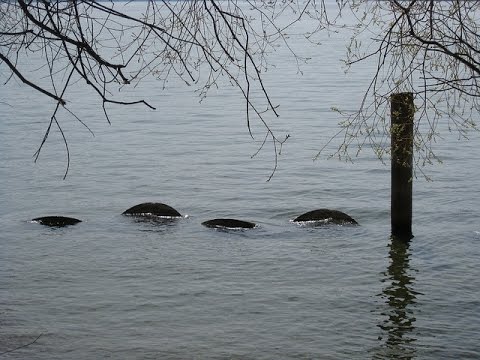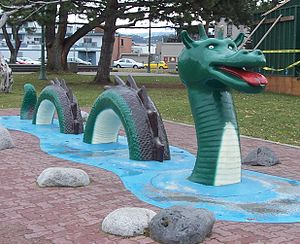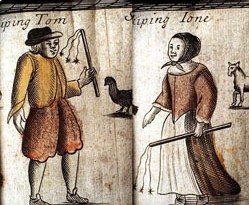OGOPOGO, The Canadian Lake Monster – Unexplained Mysteries
In Canadian folklore, Ogopogo or Naitaka (Salish: n’ha-a-itk, “lake demon”) is a lake monster reported to live in Okanagan Lake, in British Columbia, Canada. Ogopogo has been allegedly seen by First Nations people since the 19th century. The most common description of Ogopogo is a 40 to 50-foot-long (12 to 15 m) sea serpent. Skeptic Benjamin Radford notes that these First Nations stories were not referring to a literal lake monster like Ogopogo, but instead to a legendary water spirit.
In 1926, a sighting is claimed to have occurred at an Okanagan Mission beach. This event was supposedly witnessed by about thirty cars of people who all claimed to have seen the same thing. In 1968, Art Folden filmed what is claimed to be footage of the alleged creature, showing a large wake moving across the water. A computer analysis of the footage concluded it was a solid, three-dimensional object.[2] Folden noticed “something large and lifelike”; in the distance out on the calm water and pulled out his home movie camera to capture the object. An investigation conducted by Benjamin Radford with Joe Nickell and John Kirk for the National Geographic Channel TV show Is It Real?, in 2005 revealed that the object Folden filmed was indeed a real animal but its size had been greatly overestimated. It was probably a water fowl or beaver too far away to be identified.
In 2011, a cell phone video captured two dark shapes in the water. A suggested explanation is that the video shows two logs. Radford analyzed the video for Discovery News and concluded that The video quality is poor and the camera is shaky, but a closer look at the 30-second video reveals that, instead of one long object, there are actually two shorter ones, and they seem to be floating next to each other at slightly different angles. There are no humps, nor head, nor form; only two long, darkish, more or less straight forms that appear to be a few dozen feet long. In short, they look a lot like floating logs, which would not be surprising since Lake Okanagan has tens of thousands of logs harvested by the timber industry floating just under the lake’s surface.”
There are a number of similarities between Lake Okanagan in British Columbia and Scotland’s Loch Ness. They are both long and narrow and lie at about the same latitude. And they are each famous for their resident monsters.
The best-known Canadian lake Monster, Ogopogo, actually made its media debut long before the Loch Ness Monster. In 1926, seven years before Nessie’s came to the public’s attention, Roy W. Brown, editor of the Vancouver Sun, wrote, ” Too many reputable people have seen [the monster] to ignore the seriousness of actual facts.” While there are serious questions about whether there are non-retroactive Nessie sightings before 1930, but there are archival records of Ogopogo’s existence going back to 1872 and sightings have been reported regularly up to the present.
The creature is most often described as being one to two feet in diameter with a length of 15 to 20 feet. The head has been described variously as being horse or goat-like. One oft-mentioned characteristic of the monster is its resemblance to a log.
Cryptozoologist Roy P. Mackal believes that there is a “small population of aquatic fish-eating animals residing in Lake Okanagan.” Mackal initially assumed that the type of animal in Lake Okanagan was the same creature that he believed is in Loch Ness, but after a careful examination of the available data, he determined that the creature must be a form of primitive whale, Basilosaurus cetoides. “The general appearance of Basilosaurus tallies almost exactly with the loglike descriptions of the [Ogopogos]. Mackal spells out a detailed case for Ogopogo being a primitive whale in his book Searching for Hidden Animals.
Monster Island
There are good size Indian reserves in the Okanagan Valley. The Indians believe that small, barren Rattlesnake Island is the home of the Okanagan Lake Monster. Indians called the Okanagan Lake Monster N’ha-a-tik, and there are pictographs that some feel depict the monster near the headwaters of Powers Creek. Other native references to the Okanagan Lake Monster include the Chinook wicked one and “great-beast-on-the-lake.” In addition to the Salish N’ha-a-tik (or Na-ha-ha-itk), snake-in-the-lake was sometimes used.
The early inhabitants of the area saw the monster as a malevolent entity. Indians claimed that Monster Island’s rocky beaches were sometimes covered with the parts of animals that they had attacked and ravaged. When crossing the lake during bad weather, the Indians always carried a small animal that they would toss overboard in the middle of the lake to appease the monster, according to material in the files of the Kelowna Archives.

In 1914 a group of Nicola Valley and Westbank Indians discovered the decomposing body of an unidentified creature across from Rattlesnake Island. Five-six feet long and estimated to weigh 400 pounds, it was blue-grey. It had a tail and flippers, and an amateur naturalist in the area felt that it was a manatee. No one knew how such a creature could have gotten into the lake, and Lake monster expert Peter Costello has hypothesized that the carcass was “actually an Ogopogo, as the details of this mammal with flippers and a broad tail and dark color are all that we would expect. But the carcass was mangled so much that the long neck was already gone.”
Ogopogo footprints have also been found. Some have been irregularly shaped, others cup-like, some were like dinosaur tracks with three toes, and still others had a pad foot and eight toes! As Dr. Mackal has written, “The trouble with footprints is that anyone can fake them easily. Further, to assume that they were made by Naitaka is pure conjecture and supposition–certainly possible but without even a circumstantial link” to the few cases of Ogopogo land sightings that have been reported.
Music for a Monster
The name Ogopogo might suggest to some that it is an Indian word, but all evidence points to a modern origin. According to Mary Moon, author of Ogopogo: the Okanagan Mystery (1977), in 1924 a local named Bill Brimblecomb sang a song parodying a popular British music-hall tune at a Rotary Club luncheon in Vernon, a city in the northern Okanagan Valley. H.F. Beattie adapted the lyrics, which included the following:
I’m looking for the Ogopogo,
His mother was a mutton,
His father was a whale.
I’m going to put a little bit of salt on his tail.
Robert Columbo, in his book Mysterious Canada, notes that the Pogo Stick was a popular craze since its introduction in 1921 and this may have contributed to the name.
According to Arlene Gaal, author of Ogopogo: The True Story of the Okanagan Lake Million Dollar Monster, a Vancouver Province reporter named Ronald Kenvyn later parodied a popular British ditty and composed a song that included the following stanza:
His mother was an earwig;
His father was a whale;
A little bit of head And hardly any tail-
And Ogopogo was his name.
Thanks to these songs, the name Ogopogo stuck and the Indian name has been forgotten by all but monster buffs.
A History of Strong Sightings
While Ogopogo has never attained the fame of Nessie, the Loch Ness Monster, the creature of lake Okanagan has regularly caused quite a stir in the international press. Monster hunters from all over the world have been drawn to the area for research purposes, and many of the sightings have been as strong or stronger than those at Loch Ness. Multiple witness sightings of Ogopogo, so rare with many other controversial phenomena, have occurred on many occasions.



